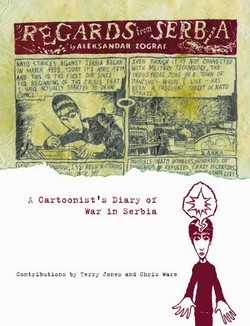Regards From Serbia
By Leroy Douresseaux
January 22, 2007 - 13:21
Top Shelf Productions
Writer(s): Aleksandar Zograf
Penciller(s): Aleksandar Zograf
Cover Artist(s): Aleksandar Zograf
ISBN: 978-891830-42-6
 |
Mr. Charlie #106 describes and examines a new work of comics journalism:
Aleksandar Zograf (birth name Saša Rakezic) is a Serbian journalist and cartoonist. Active in the international comic scene since the early 1990's, he's appeared in Fantagraphics Books' anthology title Zero Zero, and the Seattle-based company also published some of his comics, including the single-issue Life Under Sanctions and the series, Psychonaut. He was also part of that temporary 90's comic book fad, dream comics (comics drawn up from the writer or artist's dreams).
Top Shelf Productions presents Regards From Serbia, a collection of Zograf's comics and correspondence covering a period from early 1993 to mid-2001. This material also corresponds with the war in his country of Serbia (and the overall decade long Balkan war) and the NATO bombing of Zograf's hometown of Parìcevo. Regards From Serbia is basically divided into three parts. The first part opens with a cartoon introduction by Chris Ware (of Acme Novelty Library). This section also collects the aforementioned Life Under Sanctions and All Against Each Other, and short pieces like "A Day in Serbia," "All Against Each Other," and "Postcard from Pancevo."
The second section of the book opens with a satirical essay by Terry Jones (of Monty Python fame) on the NATO Alliance's bombing campaign of Serbia, which began in 1999 as way to punish then Serbian president Slobodan Miloševic. The bulk of this section belongs to Zograf's email correspondence and dispatches, originally collected in the book Bulletins from Serbia.
When the NATO bombings began, Zograf says that he found so many of the friends he'd made in the international alternative comics community were flooding him with messages and phone calls of concern. His email dispatches were an easy way to keep his friends and acquaintances informed of his personal situation, as well as give them updates from inside Serbia. Many of these communiqués were spread beyond Zograf's circle of friends, and according to the author ended up being posted on various websites and printed in newspapers and magazines.
The final third of the book contains this volume's namesake, a weekly one-page comic strip, entitled Regards from Serbia. According to Zograf, Chris Ware suggested that he chronicle the NATO bombing campaign of his hometown, and these weekly strips also ended up on websites and in magazines. Zograf kept drawing Regards from Serbia even after the bombing stopped (June 1999), and he began to chronicle the political and social upheaval that followed, including the fall of Miloševic.
The book closes with an essay/article entitled "State of Emergency in Serbia" which details March 12, 2003 assassination of Serbian President Zoran Ðindic (which I actually remember) and how it galvanized the country to take on the political corruption and criminal organizations that both indirectly and directly led to the cold-blooded murder of Ðindic. The final piece is a one-page update from March 11, 2006 about Miloševic's death while in prison.
Zograf can be described as a journalist and cartoonist similar to Joe Sacco. Through his comic book series, Palestine (collected in book form by Fantagraphics) and his single-volume Safe Area Gorazde (which also covered the war in the Balkans), Sacco came to epitomize the cartoonist-journalist that reports via comix rather than through words and photographs. Sacco, however, takes an almost documentary approach to reporting. Zograf is more personal and introspective. He documents his interior world (dreams, feelings, thoughts, etc.) and filters the exterior world through his visions and perspective.
We see the exterior world, however, through the vivid imagery and symbolism he uses. It's a heightened sense of reality that often leaps into the surreal. While he might be like Sacco, Zograf is closer in style and textual approach to R. Crumb (whom he often mentions in his comix) and Art Spiegelman, and there are times when his comic art resembles the work of Windsor McCay and the art that makes up the animated films of Walt Disney (Disney characters also show up in Zograf's work).
The blend of biography and recent history with cartoon surrealism in Zograf's work is so much like R. Crumb true-life comix that it's hard to read Regards From Serbia and not think of classic Crumb comix. This is simply a grand way to view history - through the mind of an imaginative visual artist. Not only does Zograf bring history to life, but he also makes it alive with wild and magical energy. We can believe in him no matter how strange he gets because Zograf actually lived these experiences.
Top Shelf also sells its titles at the company website, topshelfcomix.com
I also write movie reviews at http://www.negromancer.com.
Related Articles:
Fatherland comics review
